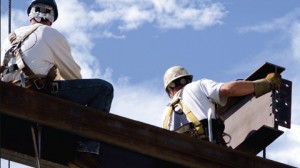NAIOP: CRE Construction, Development Added $262B to GDP in 2011
The U.S. economy looks to be weathering the economic storm quite well as 2012 roars into its second quarter. A new report by NAIOP, the Commercial Real Estate Development Association, found that commercial real estate development contributed $261.6 billion to the U.S. GDP in 2011, including $137.8 billion in hard-cost construction spending as well as…
 The U.S. economy looks to be weathering the economic storm quite well as 2012 roars into its second quarter.
The U.S. economy looks to be weathering the economic storm quite well as 2012 roars into its second quarter.
A new report by NAIOP, the Commercial Real Estate Development Association, found that commercial real estate development contributed $261.6 billion to the U.S. GDP in 2011, including $137.8 billion in hard-cost construction spending as well as $123.8 billion in soft costs, site development and tenant improvements. The full extent of that $261.6 billion, however, will be felt through both direct spending and the “cumulative economic benefits resulting from the re-spending of these outlays (the multiplier effect),” the report noted.
The report — with the official title “How Office, Industrial and Retail Development and Construction Contributed to the U.S. Economy in 2011” — was far-reaching in its reporting, noting that, following five years of contraction, construction began its recovery in 2011. Employment in the sector increased by 65,000 jobs and, while overall spending was down 2 percent from 2010 to 2011, several subcategories were either net positive over the year or turned positive during that period. Moving forward, forecasts for 2012 call for construction spending on both residential and non-residential projects to increase and then to accelerate into 2013 and 2014.
The study’s authors were quick to note, though, that “until residential and non-residential building construction spending are both increasing, the U.S. economy will not achieve a GDP growth rate sufficient to generate the job-growth levels required to significantly reduce unemployment and to assure economic stability.”
As construction outlays move toward normal levels over the 2012-2014 period, the U.S. economy’s growth rate is projected to increase from 1.7 percent in 2011 to 3.4 percent in 2014. During the second half of 2011 some signs of construction spending gains emerged in multi-family residential. With projections that both residential construction outlays will accelerate in 2012 and 2013 and non-residential construction spending will accelerate in 2013 and 2014, the U.S. economy will experience a significant increase in its growth rate. GDP and employment growth rates are both projected to attain their highest levels of the current business cycle by the end of 2014 as increases in residential and non-residential construction outlays combine to generate significant new capital spending and job growth.
And while the report noted a number of significant trends within that construction outlook, the impact on the macroeconomic picture was sizable. “The construction sector contributed to the national economy’s acceleration during 2011 with investment (expenditures) in non-residential structures’ construction increasing 4.4 percent after decreasing in 2009 (-21.2 percent) and 2010 (-15.8 percent),” it noted. The total impact of all construction spending, from direct and indirect sources, accounted for 15 percent of all economic activity in 2011.
Several categories of construction experienced renewed growth during 2011: Multi-family’s outlays increased throughout the year, especially during the second half. Office-construction outlays, after peaking in 2007, declined each year through 2010, falling from $32.6 billion to $15.7 billion over that period. But that decline was mitigated last year: The percent change from 2010 to 2011 was the smallest annual decrease registered since the economic downturn began. Retail, too, saw a small decline in construction spending, but it fell by only 1.5 percent from 2010 to 2011 — the smallest drop in a four-year span.
In contrast, spending for industrial and warehouse/flex space turned positive in 2011, with the value of construction increasing 60.8 percent in 20100 and exceeding total outlays in the category during 2005, 2006 and 2009. “Outlays for warehouse/flex construction registered a 17.8 percent increase over 2010, but remained well below the peak value of $13.4 billion in 2007,” the report noted.







You must be logged in to post a comment.